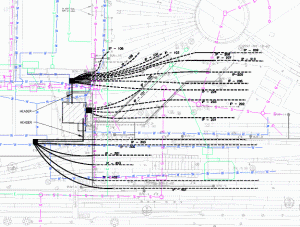What happens when you don’t have a good Horizontal Remediation Well design? It doesn’t work!
Designing a Horizontal Remediation Well is not as simple as drilling holes in a piece of HDPE pipe with a hand tool.
A story was relayed to us by an environmental consultant that hired a local directional driller to install a horizontal well. The directional driller slotted the pipe by drilling holes with a hand tool and then installed the well like it was a piece of conduit. The well did not work! In fact, the lack of design of this horizontal well has created major problems at the site that will impact it for many years.
What is involved in designing a Horizontal Remediation Well?
Designing successful Horizontal Remediation Wells is a bit more complicated and encompasses many factors including: site constraints, business continuation, appropriate horizontal well material, the length of the horizontal well screen and the size of the well screen slotting, depth, plume location, type of remedial technology, size of equipment, remediation goals and, of course, every site has site-specific needs.
Horizontal Well Designs in both well placement and well screen design can have long-term site consequences. Good horizontal well placement design takes into consideration set back, interferences, utilities, structures, zone of influence, size of the site, site closure goals and many other factors.
Additionally, there are several critical pieces of information required when designing a Horizontal Remediation Well, including:
Project goals
- i.e., what do you hope to accomplish when designing the horizontal well?
Site closure timeframe
- i.e., how quickly do you want to permanently close the site?
Site physical and chemical features
- i.e., what are the dimensions of the impacted area(s), what are the site’s hydraulic properties and what chemical constituent(s) are present at concentrations above regulatory thresholds? These elements are explored in greater detail in the following paragraphs.

It is critical to know what the goals are when designing a Horizontal Remediation Well. For example, is the goal to establish hydraulic control and let closure be achieved via monitored natural attenuation, or is the goal to aggressively attack the contamination mass via in situ remediation technologies? This has a direct bearing on designing a horizontal well.
Knowing the site closure timeframe is also critical when designing a Horizontal Remediation Well. Is a developer anxious to redevelop the site into a shopping mall in less than two years, or is it anticipated that cleanup can proceed at a measured pace over a ten-year period? The answers to these questions will have an impact on the number of horizontal wells that must be designed, their size and the size of any surface equipment, such as blowers, pumps, and motors, required to complete the horizontal remediation system.
It is also critical to know the site’s physical and chemical parameters before designing a horizontal well for remediation. Are there chemical constituents present that will attack/dissolve polyvinyl chloride pipe, requiring the use of alternate materials, such as fiberglass. It is obvious that this information must be available to the design engineer before designing the horizontal well.
At Directional Technologies, Inc., we work with our clients to provide both horizontal well layouts and horizontal well screen design. We utilize our past experience of horizontal well performance to provide the most cost-effective remediation plan.
Our experience in designing and installing Horizontal Remediation Well systems range from a small dry cleaner site with only a 35’ horizontal well to major industrial sites with thousands of feet of horizontal wells. We are recognized internationally for our expertise in horizontal remediation systems. Our staff will ensure that when designing horizontal wells for your site, you have the efficiency that you require and our staff will design your horizontal well to help you achieve your remediation goals.